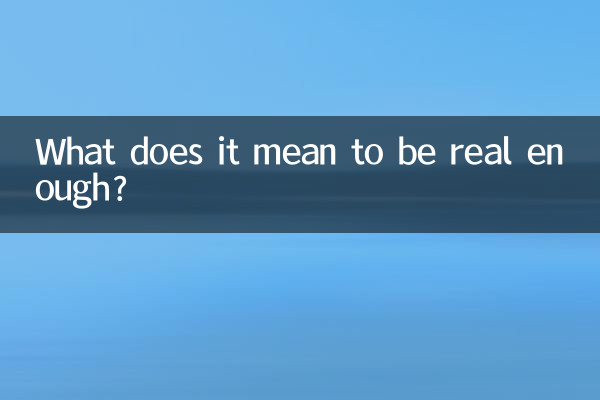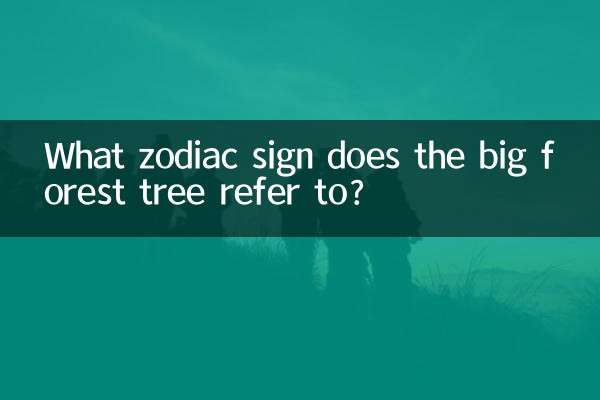What does it mean to be real enough?
In the era of information explosion, the term "enough to be true" appears frequently in social media and news reports. It is usually used to describe something or information that is so realistic that it is difficult to tell whether it is true or false. This article will combine the hot topics and hot content on the Internet in the past 10 days to deeply explore the meaning of "enough to be true" and its performance in modern society.
1. The core meaning of "enough to confuse the truth"

"Enough to confuse the real" literally means that something or a phenomenon is real enough to confuse people and make it difficult to tell whether it is real or fake. This idiom is often used to describe:
1. A superb imitation or work of art
2. Digital technologies that look fake and real (such as deep fakes)
3. Carefully crafted false information
4. Highly realistic virtual reality experience
2. The phenomenon of "insufficiently convincing" in recent hot topics
Through the tracking and analysis of hot topics across the Internet in the past 10 days, we found the following typical cases that are "confident enough to be true":
| category | hot events | Involving platforms | heat index |
|---|---|---|---|
| AI generated content | A celebrity’s AI face-changing video goes viral | Douyin, Weibo | 9.2/10 |
| market fraud | High imitation luxury goods are selling well online | Taobao, Pinduoduo | 8.7/10 |
| Internet fraud | Impersonating bank customer service fraud case | WeChat, phone | 8.5/10 |
| virtual reality | A certain game’s VR experience was praised as “real” | Station B, Steam | 8.3/10 |
| social media | Controversy over "photo fraud" of internet celebrity attractions | Xiaohongshu, Instagram | 8.0/10 |
3. Technical support behind "enough to be real"
Modern technology has made it easier than ever to "look real". The following are the main technical means supporting this phenomenon:
| technology type | Application scenarios | Development status | Potential risks |
|---|---|---|---|
| Deepfake | Video/audio synthesis | Technology is mature and tools are popular | Political rumors, pornographic content |
| Generative AI | Text/Image Creation | Tools such as ChatGPT are popular | Academic fraud, fake news |
| 3D printing | Product imitation | Micron level accuracy | intellectual property infringement |
| VR/AR | virtual experience | Immersion is greatly improved | Realistic cognitive impairment |
4. How to identify information that is “sufficiently misleading”
Faced with an information environment where it is increasingly difficult to distinguish authenticity from falsehood, we recommend the following methods to improve discrimination capabilities:
1.Multi-party verification: Do not easily trust a single source of information and cross-verify information through multiple authoritative channels.
2.Technical testing: Use professional tools to detect whether images and videos have been processed by AI
3.Observation of details: Pay attention to unnatural details, such as shadows that do not conform to physical laws, uncoordinated body movements, etc.
4.Be skeptical: Be wary of content that is too polished or too inflammatory
5.Improve literacy: Continuously learn new technical knowledge and understand the latest counterfeiting methods
5. The social impact of the phenomenon of "insufficiently convincing the truth"
This phenomenon is profoundly changing our society:
1.crisis of confidence: Public trust in the media and authoritative institutions has declined.
2.legal challenge: The existing legal system is difficult to cope with new counterfeiting technologies
3.cognitive restructuring: People need to relearn how to recognize and judge reality
4.business change: Services to verify authenticity become an emerging industry
5.education transformation: Information literacy education has become a compulsory course
6. Response suggestions
In response to the increasingly common phenomenon of "insufficiently convincing", we recommend:
| main body | Recommended actions | expected effect |
|---|---|---|
| government departments | Formulate special regulations and establish testing institutions | Standardize technology applications |
| technology company | Develop anti-counterfeiting technology and label AI content | Increase transparency |
| educational institution | Strengthen information literacy education | Improve public discernment |
| media platform | Improve content review mechanism | Reduce false propaganda |
| individual user | Develop critical thinking | Enhance self-protection |
In this "post-truth" era, "enough to confuse the truth" is no longer a simple adjective, but has become a social reality that we must face. Only through multi-party collaboration, technical prevention and educational guidance can we maintain clear understanding and judgment in this ocean of information that is difficult to distinguish between true and false.

check the details

check the details